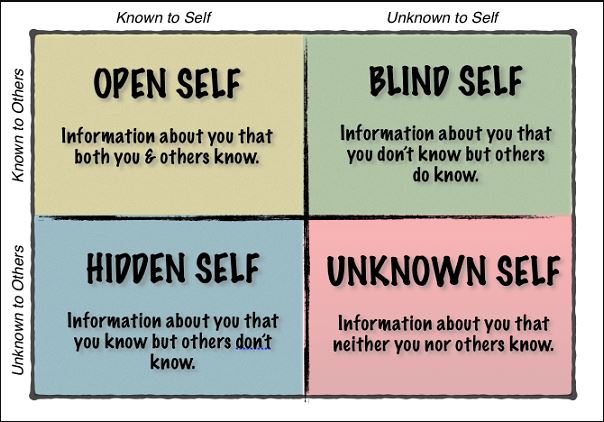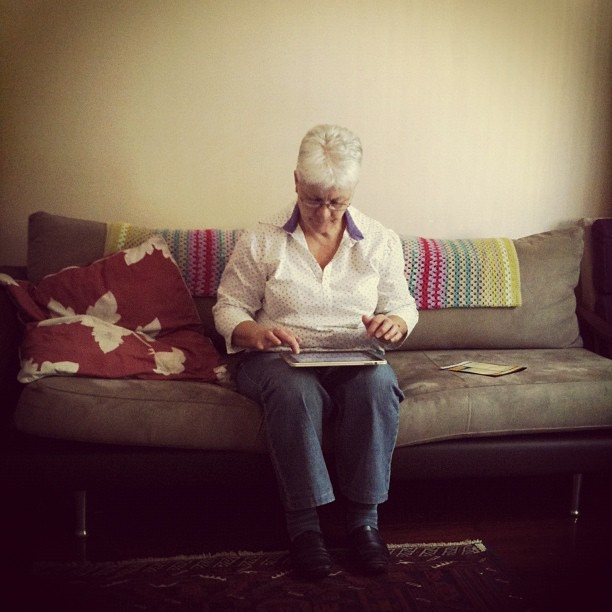5.7 Social Media and Relationships
Learning Objectives
- Explain self-disclosure in an online environment.
- Use privacy settings to protect information.
- Discuss social media and relationship management
- Explain online dating advantages and disadvantages.
Social Media and Relationships
We spend much of our time on new media designed to connect us with others. We present an online identity we want others to see using self-disclosure. While social media allows for us to create and maintain relationships, there are dangers in sharing information in an online environment. This section explores some of the characteristics of social media and relationships.
Online self-disclosure
Previously we discussed the Johari Window and how we use self-disclosure to choose how much of ourselves we reveal to others.

In terms of social media, The Johari Window becomes an interesting theory to explore. When you edit your profile, you disclose information about yourself to others. Depending on how you have adjusted privacy settings, your entire profile (ie- your self-disclosure) can be viewed by anyone. To further complicate the issue, if you have not set your “wall” privacy to “friends only”, anyone could read your status updates as well. So, what should be a reciprocal exchange, has become a one sided exchange. The idea that someone you don’t even know could be reading your profile and wall means that you have self disclosed “your private” self and possibly your “hidden self” unbeknown to yourself. People protect the exchange of information by using privacy settings on social media.
General Privacy Settings for Social Media Users – Monitoring self-disclosure
Be wary of what you post on your social media accounts and be sure to review the privacy settings to meet your needs.
1. Use Your Friend Lists
You can create Friend Lists for all of your organizational needs, allowing you to quickly view friends by type and send messages to your lists. There are a few very important things to remember about friend lists:
- You can add each friend to more than one friend group
- Friend groups should be used like “tags” as used elsewhere around the web
- Friend Lists can have specific privacy policies applied to them
2. Remove Yourself from Search Results
As a professional, you may not want people you work with to see personal information. There are numerous reasons that individuals don’t want their information to show up in search results on social media, and it’s simple to turn off your public visibility via settings.
3. Remove Yourself from Google
Typical information displayed in a search profile is limited to your profile picture, a list of your friends, a link to add you as a friend, and a link to send you a message. By visiting the privacy settings page listed in some social media apps settings, you can control the visibility of your public search listing which is visible to Google and other search engines.
4. Avoid the Infamous Photo/Video Tag Mistake
This is the classic social media problem. You let loose for a few hours one night (or day) and photos (or videos) of the moment are suddenly posted for all to view, not just your close friends who shared the moment with you. The result can be devastating. Some people have been fired from work after incriminating photos/videos were posted for the boss to see. For others, randomly tagged photos/videos have ended relationships.
5. Protect Against Published Application Stories
Frequently when you add an application, a news feed item is immediately published to your profile. That’s why it’s important to monitor what takes place after you install an application on social media platforms. Once you install an application you should visit your profile to ensure that no notification has been posted to your profile.
More often than not, nothing will be posted, but there are many applications on the platform unfortunately that publish stories without you knowing it. There are two ways to avoid having this happen: don’t visit applications or scan your profile every time that you do. Ultimately you shouldn’t be concerned about applications that you’ve built a trusted relationship with but any new applications could potentially post embarrassing notifications.
6. Make Your Contact Information Private
For each contact item that you have in your profile, you should set custom privacy settings so that contacts that you aren’t close to don’t have access to your phone number and/or email. It’s a small change but it can save you the hassle of being pestered by people you don’t know well. Also, protecting your privacy is generally a good practice to get in the habit of doing.
Social Media’s Influence on Interpersonal Relationships
How do social media affect our interpersonal relationships, if at all? This is a question that has been addressed by scholars, commentators, and people in general. To provide some perspective, similar questions and concerns have been raised along with each major change in communication technology. New media, however, have been the primary communication change of the past few generations, which likely accounts for the attention they receive. Some scholars in sociology have decried the negative effects of new technology on society and relationships in particular, saying that the quality of relationships is deteriorating and the strength of connections is weakening (Richardson & Hessey, 2009).
Facebook greatly influenced our use of the word friend, although people’s conceptions of the word may not have changed as much. When someone “friends you” on Facebook, it doesn’t automatically mean that you now have the closeness and intimacy that you have with some offline friends. And research shows that people don’t regularly accept friend requests from or send them to people they haven’t met, preferring instead to have met a person at least once (Richardson & Hessey, 2009). Some users, though, especially adolescents, engage in what is called “friend-collecting behavior,” which entails users friending people they don’t know personally or that they wouldn’t talk to in person in order to increase the size of their online network (Christofides, Muise, & Desmarais, 2012). As we will discuss later, this could be an impression management strategy, as the user may assume that a large number of Facebook friends will make him or her appear more popular to others.
Although many have critiqued the watering down of the term friend when applied to Social networking sites (SNSs), specifically Facebook, some scholars have explored how the creation of these networks affects our interpersonal relationships and may even restructure how we think about our relationships. Even though a person may have hundreds of Facebook friends that he or she doesn’t regularly interact with on- or offline, just knowing that the network exists in a somewhat tangible form (catalogued on Facebook) can be comforting. Even the people who are distant acquaintances but are “friends” on SNS can serve important functions. Rather than users seeing these connections as pointless, frivolous, or stressful, they are often comforting background presences. A dormant network is a network of people with whom users may not feel obligated to explicitly interact but may find comfort in knowing the connections exist. Such networks can be beneficial, because when needed, a person may be able to more easily tap into that dormant network than they would an offline extended network. It’s almost like being friends on SNS keeps the communication line open, because both people can view the other’s profile and keep up with their lives even without directly communicating. This can help sustain tenuous friendships or past friendships and prevent them from fading away, which as we learned is a common occurrence as we go through various life changes.
A key part of interpersonal communication is impression management, and some forms of new media allow us more tools for presenting ourselves than others. SNS in many ways are platforms for self-presentation. Even more than blogs, web pages, and smartphones, the environment on an SNS like Facebook or Twitter facilitates self-disclosure in a directed way and allows others who have access to our profile to see our other “friends.” This convergence of different groups of people (close friends, family, acquaintances, friends of friends, colleagues, and strangers) can present challenges for self-presentation. Research shows half of all US adults have a profile on Facebook or another SNS (Vitak & Ellison). The fact that Facebook is expanding to different generations of users has coined a new phrase—“the graying of Facebook.” This is due to a large increase in users over the age of fifty-five. In fact, it has been stated the fastest-growing Facebook user group is women fifty-five and older, which is up more than 175 percent since fall 2008 (Gates, 2009). So now we likely have people from personal, professional, and academic contexts in our Facebook network, and those people are now more likely than ever to be from multiple generations. The growing diversity of our social media networks creates new challenges as we try to engage in impression management.
People fifty-five and older are using new media in increasing numbers.
Marg O’Connell – Grandma kicks it with the iPad 🙂 – CC BY-NC 2.0.
We should be aware that people form impressions of us based not just on what we post on our profiles but also on our friends and the content that they post on our profiles. In short, as in our offline lives, we are judged online by the company we keep (Walther et al., 2008). The difference is, though, that via Facebook a person (unless blocked or limited by privacy settings) can see our entire online social network and friends, which doesn’t happen offline. The information on our profiles is also archived, meaning there is a record the likes of which doesn’t exist in offline interactions. Recent research found that a person’s perception of a profile owner’s attractiveness is influenced by the attractiveness of the friends shown on the profile. In short, a profile owner is judged more physically attractive when his or her friends are judged as physically attractive, and vice versa. The profile owner is also judged as more socially attractive (likable, friendly) when his or her friends are judged as physically attractive. The study also found that complementary and friendly statements made about profile owners on their wall or on profile comments increased perceptions of the profile owner’s social attractiveness and credibility. An interesting, but not surprising, gender double standard also emerged. When statements containing sexual remarks or references to the profile owner’s excessive drinking were posted on the profile, perceptions of attractiveness increased if the profile owner was male and decreased if female (Walther et al., 2008).
Self-disclosure is a fundamental building block of interpersonal relationships, and new media make self-disclosures easier for many people because of the lack of immediacy, meaning the fact that a message is sent through electronic means arouses less anxiety or inhibition than would a face-to-face exchange. SNSs provide opportunities for social support. Research has found that Facebook communication behaviors such as “friending” someone or responding to a request posted on someone’s wall lead people to feel a sense of attachment and perceive that others are reliable and helpful (Vitak & Ellison). Much of the research on Facebook, though, has focused on the less intimate alliances that we maintain through social media. Since most people maintain offline contact with their close friends and family, Facebook is more of a supplement to interpersonal communication. Since most people’s Facebook “friend” networks are composed primarily of people with whom they have less face-to-face contact in their daily lives, Facebook provides an alternative space for interaction that can more easily fit into a person’s busy schedule or interest area. For example, to stay connected, both people don’t have to look at each other’s profiles simultaneously. I often catch up on a friend by scrolling through a couple of weeks of timeline posts rather than checking in daily.
The space provided by SNSs can also help reduce some of the stress we feel in regards to relational maintenance or staying in touch by allowing for more convenient contact. The expectations for regular contact with our Facebook friends who are in our extended network are minimal. An occasional comment on a photo or status update or an even easier click on the “like” button can help maintain those relationships. However, when we post something asking for information, help, social support, or advice, those in the extended network may play a more important role and allow us to access resources and viewpoints beyond those in our closer circles. And research shows that many people ask for informational help through their status updates (Vitak & Ellison).
These extended networks serve important purposes, one of which is to provide access to new information and different perspectives than those we may get from close friends and family. For example, since we tend to have significant others that are more similar to than different from us, the people that we are closest to are likely to share many or most of our beliefs, attitudes, and values. Extended contacts, however, may expose us to different political views or new sources of information, which can help broaden our perspectives. The content in this section hopefully captures what I’m sure you have already experienced in your own engagement with new media—that new media have important implications for our interpersonal relationships. Given that, we will end this chapter with a “Getting Competent” feature box that discusses some tips on how to competently use social media.
“Getting Competent”
Using Social Media Competently
We all have a growing log of personal information stored on the Internet, and some of it is under our control and some of it isn’t. We also have increasingly diverse social networks that require us to be cognizant of the information we make available and how we present ourselves. While we can’t control all the information about ourselves online or the impressions people form, we can more competently engage with social media so that we are getting the most out of it in both personal and professional contexts.
A quick search on Google for “social media dos and don’ts” will yield around 100,000 results, which shows that there’s no shortage of advice about how to competently use social media. I’ll offer some of the most important dos and don’ts that I found that relate to communication (Doyle, 2012). Feel free to do your own research on specific areas of concern.
Be consistent. Given that most people have multiple social media accounts, it’s important to have some degree of consistency. At least at the top level of your profile (the part that isn’t limited by privacy settings), include information that you don’t mind anyone seeing.
Know what’s out there. Since the top level of many social media sites are visible in Google search results, you should monitor how these appear to others by regularly (about once a month) doing a Google search using various iterations of your name. Putting your name in quotation marks will help target your results. Make sure you’re logged out of all your accounts and then click on the various results to see what others can see.
Think before you post. Software that enable people to take “screen shots” or download videos and tools that archive web pages can be used without our knowledge to create records of what you post. While it is still a good idea to go through your online content and “clean up” materials that may form unfavorable impressions, it is even a better idea to not put that information out there in the first place. Posting something about how you hate school or your job or a specific person may be done in the heat of the moment and forgotten, but a potential employer might find that information and form a negative impression even if it’s months or years old.
Be familiar with privacy settings. If you are trying to expand your social network, it may be counterproductive to put your Facebook or Twitter account on “lockdown,” but it is beneficial to know what levels of control you have and to take advantage of them. For example, I have a “Limited Profile” list on Facebook to which I assign new contacts or people with whom I am not very close. You can also create groups of contacts on various social media sites so that only certain people see certain information.
Be a gatekeeper for your network. Do not accept friend requests or followers that you do not know. Not only could these requests be sent from “bots” that might skim your personal info or monitor your activity; they could be from people that might make you look bad. Remember, we learned earlier that people form impressions based on those with whom we are connected. You can always send a private message to someone asking how he or she knows you or do some research by Googling his or her name or username.
- Identify information that you might want to limit for each of the following audiences: friends, family, and employers.
- Google your name (remember to use multiple forms and to put them in quotation marks). Do the same with any usernames that are associated with your name (e.g., you can Google your Twitter handle or an e-mail address). What information came up? Were you surprised by anything?
- What strategies can you use to help manage the impressions you form on social media?
Online Dating
A significant part of human social life is organized around who we form lasting romantic relationships with. The online world, once idealized as a place of anonymity and separation from offline life, now has networks devoted to replicating offline life online, and building networks of relationships. These interconnected relationships are what experts really mean when we talk about social networks, which sociologists began studying decades before online social networking sites existed.
DATING ON SOCIAL MEDIA: AUTHENTICITY VS. STRUCTURE
Student Content, Fall 2020
Boyfriends and Social Media
What Social Media Means to Me
For me social media has always been a safe space for me to be my authentic self. Starting it in the 5th grade, I had no intent to show off or impress anyone. I would post maybe five times a day and I wouldn’t even care what I posted about. However, I noticed recently that I have started to fold into the mix of overthinking instagram and thinking too much about the traditions within it.
Instagram is so big that it has its own culture, its own language, its own traditions. And as users we have the option to adhere to these or follow our own path. The societal pressure, and especially being 19, it’s hard to not just follow the status quo. I have tried to go down my own path of not caring what other people think about my profile, but over time it has gotten harder to not just post for me. You find yourself wanting to post to impress your mom, friends, and other acquaintances.
In my podcast I discuss with my boyfriend Alec, the peer pressure I felt of us posting about each other for the first time. As a guy, who despite his resistance, follows his own set of traditions on social media. We relayed how as a culture we perform or act on our posts. As a little girl the biggest deal to me was to be able to post pictures of my boyfriend as I got older because that’s what I saw my older cousins do and what I was looking forward to be able to do. When Alec and I were able to visit each other during the summer, I knew that we had to get the perfect photo for instagram. And for the most part there were great moments of just us living in the moment, which I really tried to stick with, but then I remembered the pressure I felt. This pressure stems from years of social anxiety and having my ow insecurities.
Talking with Alec made me realize how much power I give social media, and I think that goes with a lot of other people. We are given these standards or traditions and told to stick with them, and if we don’t we will be criticized. And I think that nowadays there is too much power that social media gets, power I no longer want to give. I mean, instead of enjoying time in front of the golden gate bridge with my boyfriend, I made us put up a facade that we were having a perfect time. And as much as it was great, it wasn’t perfect, because nothing is!
Overall, what I learned from this experience and being able to state it out loud was that I no longer want social media to have power over me. I want to be able to have freedom and express whatever I want. Whether that’s a political opinion, an outfit I would have otherwise not shown, or really goofy photos that I would have normally been too embarrassed to share. For the sake of my mental health and overall enjoyment of the app, I want to let social media be fun and not always have to follow the typical traditions that come with it.
About the Author
Alyssa De Leon is a current sophomore at the University of Arizona. She is a film and television major from northern California. She spends quarantine watching reality tv and baking.

In a 2014 article entitled From Facebook to Cell Calls, Yang and coauthors found that college students progressed through layers of electronic intimacy – different media chosen as benchmarks in the progression of a romantic relationship. When they were interested in someone, they began by connecting with a “crush” through Facebook, which allowed the “crush” to see who their admirer’s friends were and how the admirer looked, communicated, and behaved. The next layer was instant messaging – direct communication, but not as direct as the use of one’s “digits” or cellular connection. After instant messaging, they moved to the more intimate sanctum of text messaging. The final step was a face-to-face meeting. Overall this sequence of media they used followed a pattern: they began by performing in front of and viewing one another’s social networks, they then moved into more direct one-on-one communication before meeting in person.
Data in the above study was likely collected in 2011 or 2012. So what might people like the participants in Yang and coauthors’ study be doing to find romance now, five years later? College students today may be using some different platforms in their pursuit of new connections than the students in Yang et al’s study; Instagram is likely high on the list.
However, it is also likely that at least some of the pursuit of romantic interests that happened through different media in the past is now consolidating in online dating sites. The Pew Research Center published a report in 2016 about the growing number of Americans who have used online dating. They found that online dating usage by those aged 18-24 has nearly tripled since 2013 and usage by those aged 55-64 has doubled; other age groups’ use has increased as well.
Online dating apps afford the presentation of ourselves to prospective friends, partners, mates, and hookups. On these apps, users’ imagery and self-description tend to be idealized, sometimes to the point of deception. Apps such as settleforlove.com have been developed around the desire for more honesty in online dating, but their market share has not been spectacular. It seems upfront honesty is not the best way to gather a public of potential lovers.
Do dating apps also follow the sequence found in Yang and coauthors’ study, moving from social and tribal to direct connection? That depends. Some apps leave out learning about someone’s social connections, relying instead on complex algorithms to calculate who might be a good match – even if scientific evidence does not show that these algorithms work. Others just speed through the sequence by facilitating immediate direct connection, and in some cases, quick sex. Some use the language of sociality like “tribe” and some connect you to matches through your social networks.
But we humans and our cultural norms still determine a great deal of how dating apps are used. Just as bias affects algorithms across the web, bias has been found to tip the scales on dating sites in favor of white men, to the detriment of groups including black women and Asian men. Sites and apps follow our leads as much as we follow theirs. And apps only go so far; dating apps today function more like online shopping than like relationship formation of the past. In the BBC Horizon film How to Find Love Online, the romance-focused anthropologist Dr. Helen Fisher says they are better called “Introduction services,” with the act of dating and the final vetting before it still conducted in person.
Mobile Dating Apps
Mobile apps are particularly influential in the world of online dating today. One of the pioneers was Grindr, a gay dating app. Bae, an up and coming site branded “for black singles,” was recently acquired by a company aiming to make it global. Her caters to queer women.
And then there is Tinder, the most popular in the US (although not the world) at the time of this writing, which has taken the heterosexual dating world by storm. There are many critiques of Tinder’s effect on heterosexual dating, however, including studies finding that it favors men’s usage norms over women’s. Tinder faces strong competition from numerous competitors for the US market, however, including a direct challenge – with a grudge – from a Tinder cofounder’s site, Bumble, discussed more below.
CONNECTING, TINDER, AND THE SOCIAL MEDIA COMA
Student Content
My Perspective on Social Media Use
Living in this day and age, social media is used by millions and millions of people all around the globe. I enjoy using social media for purposes such as being social (obviously), keeping in touch with my friends and family, expressing myself, sharing some of my own personal thoughts, beliefs, and opinions, and having a platform for myself to share whatever I want, whenever I want.
Social media usage comes with many benefits and positives. However, there are also many negatives that come along with being on social media. In my own personal experience, I have gotten my feelings hurt over seeing people doing something without inviting me, leaving me to feel left out and excluded. Also, people tend to be very harsh and rude over social media because they are behind a screen and not face to face. Therefore, they may be more confident in the cruel words that they are typing. I try to use my social media as a positive additive into my life. I feel like there is already so much hate, judgement, and negativity in the world, so why should there be any more from being on social media (which is supposed to be fun)? Personally, I choose to follow accounts that preach positivity and lift my spirit, and then unfollow all the others that do the opposite.
Social media can also be very time consuming. Some days I have found myself buried in my phone on the couch or laying in bed for hours upon hours as the day wasted away. I like to call this action a “social media coma.” It is moments like those that make me feel guilty and ashamed that I actually spent countless hours on my phone, examining other people’s lives, when I am actually wasting my own by doing so.
Another aspect of social media that I do not participate in, unlike many high school students, college students, and young adults is online dating/ hooking up apps. The most popular one among this generation is Tinder. Tinder is a “dating” app where you basically judge someone in a matter of a few seconds on their looks, age, name, location, and biography (if they have one). Then, you either swipe right or left, depending on if you like what you see or not. If you match with someone, meaning both people swipe right on each other, then you can arrange plans to start talking, hanging out, or whatever else. I have an old soul and would much rather find a life partner in a more natural way… say maybe bumping into someone at the grocery store and locking eyes and feeling immediate sparks (very cliche and seen in almost every rom-com, I know)! I don’t think that there is anything wrong or shameful about Tinder or other dating apps, but I just choose to not be a part of them.
Overall, social media is very prevalent in today’s society. It can provide countless opportunities and knowledge, just at the click of your fingers. I think that using social media in moderation is a good thing to do. People should also be uplifting, supportive, and kind to one another over the screen to help make social media a healthier, happier, and safer environment.

About the author
Marissa Farhi is a college student at the University of Arizona. She loves to work out, spend time with friends and family, and eat avocado toast.
The Paradox of Choice
Some scientists and users are critical of online dating apps because of the wide selection they provide. As Aziz Ansari points out in this podcast episode, and in this article, for some people dating once meant choosing from an extremely small selection of people. He and the podcast host cite studies finding a paradox of choice, psychologist Barry Schwartz’s theory that the more selection we have, the less likely we are to choose something and feel satisfied with our choice – whether it is a partner or a jar of jam. And today? Thanks to these apps, users get exposed to a lot more jam.

Many in the article linked above, including Sales, have charged that Tinder encourages a culture of harassment of women. That may be in part because the culture within the company has been the site of harassment. Tinder co-founder Whitney Wolfe left Tinder in 2014 after being sexually harassed there, received a settlement, and started Bumble. For users in big cities, it is possible to swipe almost infinitely through prospects for dating and potential sex. As my friend Mary Franklin Harvin describes it, it gives “an air of disposability” to people. Nancy Jo Sales’ Vanity Fair article on Tinder goes further, claiming women have fewer orgasms in the numbers-game exchanges Tinder facilitates – and in these situations with so little intimacy or rapport for feedback, men do not learn the skills to be good lovers.
But online dating sites, like most technologies, depend on humans to use them and shape their norms. To end with a ray of hope for those who feel they have to use Tinder, artists like Audrey Jones, Matt Starr, and Jarrod Allen use Tinder to make art. If nothing else, they remind us that humans can choose to use platforms in new ways – even if using them differently than the crowd can be lonely.
Key Takeaways
- We use self-disclosure as we post information about ourselves online to create identities we want to share with others.
- We should be mindful of the ways we can protect our online information from those we don’t wish to share it with.
- New media affect interpersonal relationships, as conceptions of relationships are influenced by new points of connection such as “being Facebook friends.” While some people have critiqued social media for lessening the importance of face-to-face interaction, some communication scholars have found that online networks provide important opportunities to stay connected, receive emotional support, and broaden our perspectives in ways that traditional offline networks do not.
- Getting integrated: Social networking sites (SNSs) can present interpersonal challenges related to self-disclosure and self-presentation since we use them in academic, professional, personal, and civic contexts. Given that people from all those contexts may have access to our profile, we have to be competent in regards to what we disclose and how we present ourselves to people from different contexts (or be really good at managing privacy settings so that only certain information is available to certain people).
- Online dating has offers opportunities for us to meet others but also comes with many challenges
References
Christofides, E., Amy Muise, and Serge Desmarais, “Hey Mom, What’s on Your Facebook? Comparing Facebook Disclosure and Privacy in Adolescents and Adults,” Social Psychological and Personality Science 3, no. 1 (2012): 51.
Doyle, A., “Top 10 Social Media Dos and Don’ts,” About.com, accessed November 8, 2012, http://jobsearch.about.com/od/onlinecareernetworking/tp/socialmediajobsearch.htm.
Fitzgerald, B., “Social Media Is Causing Anxiety, Study Finds,” Huffington Post, July 11, 2012, accessed November 8, 2012, http://www.huffingtonpost.com/2012/07/10/social-media-anxiety_n_1662224.html.
Gates, A., “For Baby Boomers, the Joys of Facebook,” New York Times, March 19, 2009, accessed November 8, 2012, http://www.nytimes.com/2009/03/22/nyregion/new-jersey/22Rgen.html.
Kintzer, B., “Women Find Social Media Make Them More Social Offline, Too,” Advertising Age, July 9, 2012, accessed November 8, 2012, http://adage.com/article/guest-columnists/women-find-social-media-makes-social-offline/235712.
Richardson, K., and Sue Hessey, “Archiving the Self?: Facebook as Biography of Social and Relational Memory,” Journal of Information, Communication, and Ethics in Society 7, no. 1 (2009): 29.
Roy, J., “Facebook, Skype Give Cosmetic Surgery Industry a Lift,” BetaBeat.com, July 11, 2012, accessed November 8, 2012, http://betabeat.com/2012/07/facebook-skype-plastic-surgery-cosmetic-increase-07112012.
Ryan, T. and Sophia Xenos, “Who Uses Facebook? An Investigation into the Relationship between the Big Five, Shyness, Narcissism, Loneliness, and Facebook Usage,” Computers in Human Behavior 27, no. 5 (2011): 1659.
Vitak, J., Julia Crouse, and Robert LaRose, “Personal Internet Use at Work: Understanding Cyberslacking,” Computers in Human Behavior 27, no. 5 (2011): 1752.
Vitak, J. and Nicole B. Ellison, “‘There’s a Network Out There You Might as Well Tap’: Exploring the Benefits of and Barriers to Exchanging Informational and Support-Based Resources on Facebook,” New Media and Society (in press).
Walther, J. B., Brandon Van Der Heide, Sang-Yeon Kim, David Westerman, and Stephanie Tom Tong, “The Role of Friends’ Appearance and Behavior on Evaluations of Individuals on Facebook: Are We Known by the Company We Keep?” Human Communication Research 34 (2008): 29.


